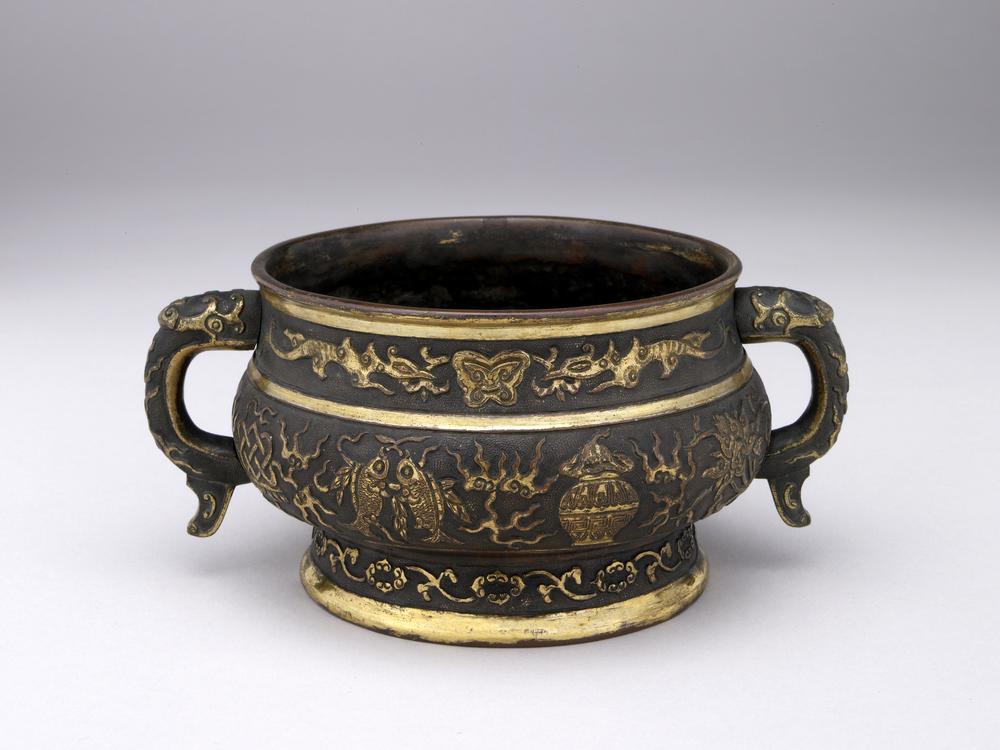Period:Northern Song dynasty Production date:970-980 (circa)
Materials:silk, 絲綢 (Chinese),
Technique:painted
Subjects:buddha bodhisattva lokapala lotus throne vajra 佛 (Chinese) 菩薩 (Chinese) 天王 (Chinese) 蓮花寶座 (Chinese) 供養人 (Chinese) 金剛 (Chinese)
Dimensions:Height: 97 centimetres Width: 74.30 centimetres
Description:
Painting with Avalokiteśvara seated on a lotus throne, shown with eleven heads and six arms, the Buddhas of the Ten Directions, bodhisattvas, lokapalas (guardian kings) and two Vajrapāṇi (thunderbolt bearers), each one flanked by a cartouche with his name. Three male and three female donors in lower section flank a central inscription panel. Gold leaf used for topmost head of Avalokiteśvara and for jewels and ornaments adorning bodhisattvas and Vajrapāṇi. Ink and colour on silk.
IMG
![图片[1]-painting; 繪畫(Chinese) BM-1919-0101-0.63-China Archive](https://chinaarchive.net/Northern Song dynasty/Paintings/mid_RFC672_Top.jpg)
![图片[2]-painting; 繪畫(Chinese) BM-1919-0101-0.63-China Archive](https://chinaarchive.net/Northern Song dynasty/Paintings/mid_RFC672_Bot.jpg)
![图片[3]-painting; 繪畫(Chinese) BM-1919-0101-0.63-China Archive](https://chinaarchive.net/Northern Song dynasty/Paintings/mid_RFC672_Whole.jpg)
Comments:EnglishFrom Whitfield 1983:Although no doubt intended to be impressive and a worthy Buddhist work by which merit could be gained, this painting remains rather pedestrian in character, as there is very little sense of an overall organization linking the various parts. Naturally, the donors and central inscription (which is not dated but must be close to around A.D. 970 or 980, see Fig. 38) are separated from the main subject by a band of lozenges, but it will be easily seen also that the figures accompanying Avalokitesvara are also fairly rigidly compartmented. Above are the Buddhas of the Ten Directions, in two groups; then Sariputra (Pl. 29-2) and Subhuti each with a guardian king; two Bodhisattvas on either side, and two fiery- headed Vajrapanis (Pl. 29-3), seated on either side of the central altar table. Features such as the rich decoration of the petals of the main lotus throne can hardly have made up for this poverty of invention, which extends to the colouring, largely restricted to green and red.The painting is still complete with its original wide border and three hanging loops of hemp cloth, originally pink in colour. Actual gold leaf has been used for the topmost head of Avalokitesvara, and for the jewels and ornaments adorning the Bodhisattvas and Vajrapanis. ChineseFrom Whitfield 1983:此畫除了主尊十一面觀音外,還配有各式各樣的像,顯得富麗堂皇,本想描繪一件高貴的佛畫,然而各部分在結構上缺乏整體感,因此仍停留在陳舊的水平。將供養人像和題記欄(沒有紀年,但應該是在970年至980年間)與主要部分隔開的的菱形相連的花紋帶,正好也把隨從觀音的諸尊清楚地區分開。畫面上方的左右,十方佛分被成兩群。其下有舍利弗(參照圖29-2)和須菩提,各自隨帶天王。其正下方的菩薩,左右各有兩身。祭壇的兩側,各坐著一身被火焰圍繞的金剛力士(參照圖29-3)。構成中尊蓮華座的蓮瓣,裝飾也很普通。整體色彩也只限於綠和紅色,缺乏創意。此畫使用的寬幅布邊和三個粉色麻吊環,至今仍保留著完整的形狀。並且在觀音頭頂部、菩薩和金剛力士的裝飾品上都使用了金箔。
Materials:silk, 絲綢 (Chinese),
Technique:painted
Subjects:buddha bodhisattva lokapala lotus throne vajra 佛 (Chinese) 菩薩 (Chinese) 天王 (Chinese) 蓮花寶座 (Chinese) 供養人 (Chinese) 金剛 (Chinese)
Dimensions:Height: 97 centimetres Width: 74.30 centimetres
Description:
Painting with Avalokiteśvara seated on a lotus throne, shown with eleven heads and six arms, the Buddhas of the Ten Directions, bodhisattvas, lokapalas (guardian kings) and two Vajrapāṇi (thunderbolt bearers), each one flanked by a cartouche with his name. Three male and three female donors in lower section flank a central inscription panel. Gold leaf used for topmost head of Avalokiteśvara and for jewels and ornaments adorning bodhisattvas and Vajrapāṇi. Ink and colour on silk.
IMG
![图片[1]-painting; 繪畫(Chinese) BM-1919-0101-0.63-China Archive](https://chinaarchive.net/Northern Song dynasty/Paintings/mid_RFC672_Top.jpg)
![图片[2]-painting; 繪畫(Chinese) BM-1919-0101-0.63-China Archive](https://chinaarchive.net/Northern Song dynasty/Paintings/mid_RFC672_Bot.jpg)
![图片[3]-painting; 繪畫(Chinese) BM-1919-0101-0.63-China Archive](https://chinaarchive.net/Northern Song dynasty/Paintings/mid_RFC672_Whole.jpg)
Comments:EnglishFrom Whitfield 1983:Although no doubt intended to be impressive and a worthy Buddhist work by which merit could be gained, this painting remains rather pedestrian in character, as there is very little sense of an overall organization linking the various parts. Naturally, the donors and central inscription (which is not dated but must be close to around A.D. 970 or 980, see Fig. 38) are separated from the main subject by a band of lozenges, but it will be easily seen also that the figures accompanying Avalokitesvara are also fairly rigidly compartmented. Above are the Buddhas of the Ten Directions, in two groups; then Sariputra (Pl. 29-2) and Subhuti each with a guardian king; two Bodhisattvas on either side, and two fiery- headed Vajrapanis (Pl. 29-3), seated on either side of the central altar table. Features such as the rich decoration of the petals of the main lotus throne can hardly have made up for this poverty of invention, which extends to the colouring, largely restricted to green and red.The painting is still complete with its original wide border and three hanging loops of hemp cloth, originally pink in colour. Actual gold leaf has been used for the topmost head of Avalokitesvara, and for the jewels and ornaments adorning the Bodhisattvas and Vajrapanis. ChineseFrom Whitfield 1983:此畫除了主尊十一面觀音外,還配有各式各樣的像,顯得富麗堂皇,本想描繪一件高貴的佛畫,然而各部分在結構上缺乏整體感,因此仍停留在陳舊的水平。將供養人像和題記欄(沒有紀年,但應該是在970年至980年間)與主要部分隔開的的菱形相連的花紋帶,正好也把隨從觀音的諸尊清楚地區分開。畫面上方的左右,十方佛分被成兩群。其下有舍利弗(參照圖29-2)和須菩提,各自隨帶天王。其正下方的菩薩,左右各有兩身。祭壇的兩側,各坐著一身被火焰圍繞的金剛力士(參照圖29-3)。構成中尊蓮華座的蓮瓣,裝飾也很普通。整體色彩也只限於綠和紅色,缺乏創意。此畫使用的寬幅布邊和三個粉色麻吊環,至今仍保留著完整的形狀。並且在觀音頭頂部、菩薩和金剛力士的裝飾品上都使用了金箔。
© Copyright
The copyright of the article belongs to the author, please keep the original link for reprinting.
THE END
![[Qing Dynasty] British female painter—Elizabeth Keith, using woodblock prints to record China from the late Qing Dynasty to the early Republic of China—1915-China Archive](https://chinaarchive.net/wp-content/uploads/2022/11/image-191x300.png)




